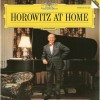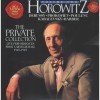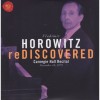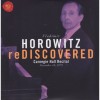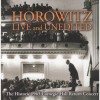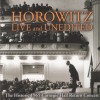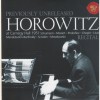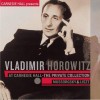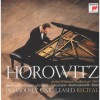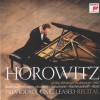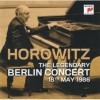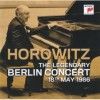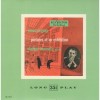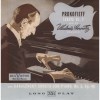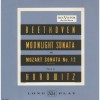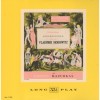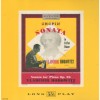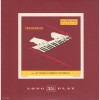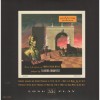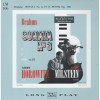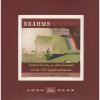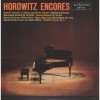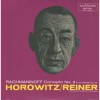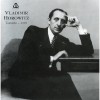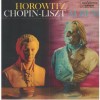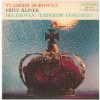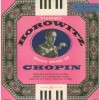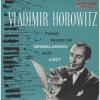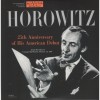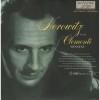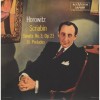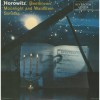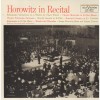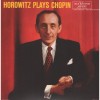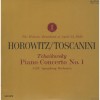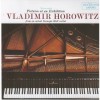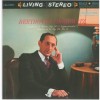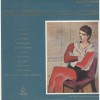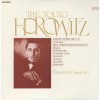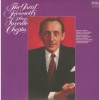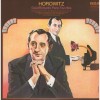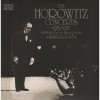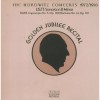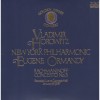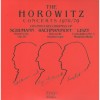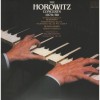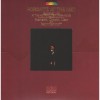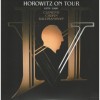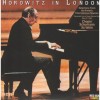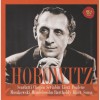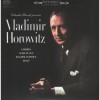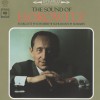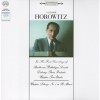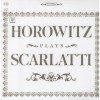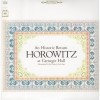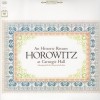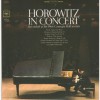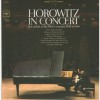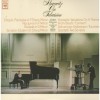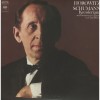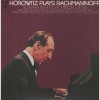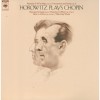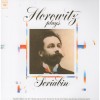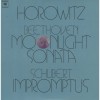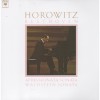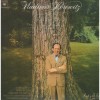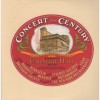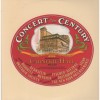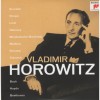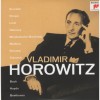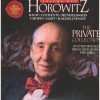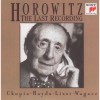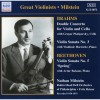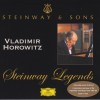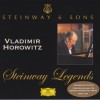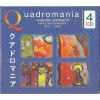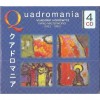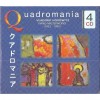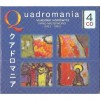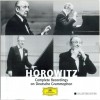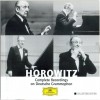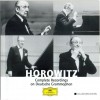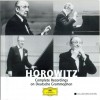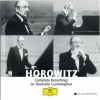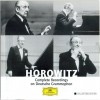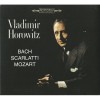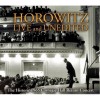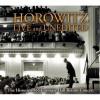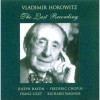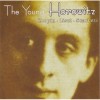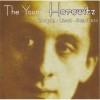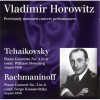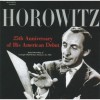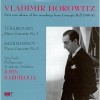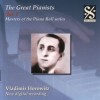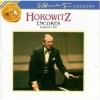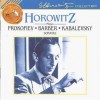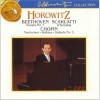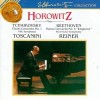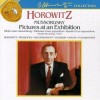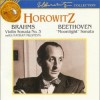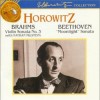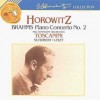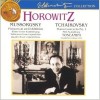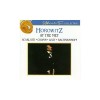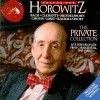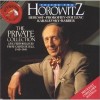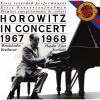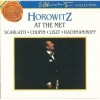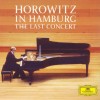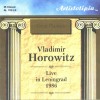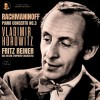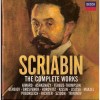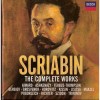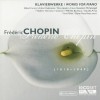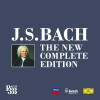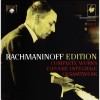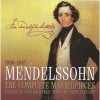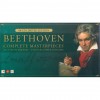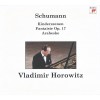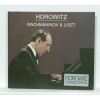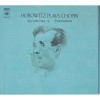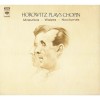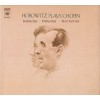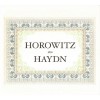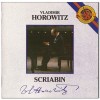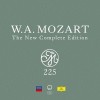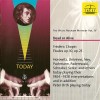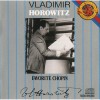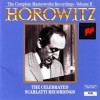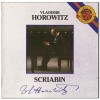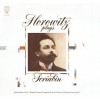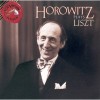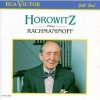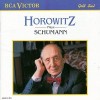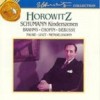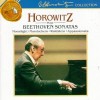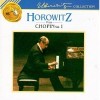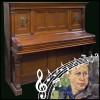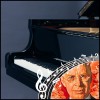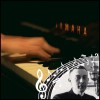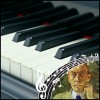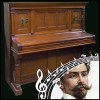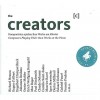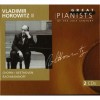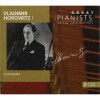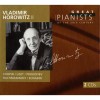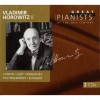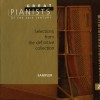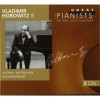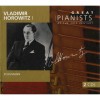| Voice/Instrument: | Pianoforte |
Biography
Vladimir Horowitz was born in Kiev[4] in the Russian Empire (now the capital of Ukraine). Some claim that Horowitz was born in Berdychiv, however his birth certificate shows Kiev as his birthplace.
Horowitz was the youngest of four children of Samuil Horowitz and Sophia Bodik, who were assimilated Jews. Samuil Horowitz was a well-to-do electrical engineer and the distributor of electric motors for German manufacturers. Horowitz's grandfather Joachim was a merchant (and an arts-supporter), belonging to the 1st Guild. This status gave exemption from having to reside in the Pale of Settlement. Horowitz was born in 1903, but in order to make him appear too young for military service so as not to risk damaging his hands, his father took a year off his son's age by claiming he was born in 1904. The 1904 date appeared in many reference works during the pianist's lifetime.
Horowitz received piano instruction from an early age, initially from his mother, who was herself a pianist. In 1912 he entered the Kiev Conservatory, where he was taught by Vladimir Puchalsky, Sergei Tarnowsky, and Felix Blumenfeld. His first solo recital was in Kharkiv in 1920.
Horowitz's fame grew, and he soon began to tour Russia where he was often paid with bread, butter and chocolate rather than money, due to the country's economic hardships caused by the Civil War. During the 1922–1923 season, he performed 23 concerts of eleven different programs in Petrograd alone. Despite his early success as a pianist, Horowitz maintained that he wanted to be a composer, and only undertook a career as a pianist to help his family, who had lost their possessions in the Russian Revolution.
In December 1925, Horowitz crossed the border into the West, ostensibly to study with Artur Schnabel. Privately intending not to return, the pianist had stuffed American dollars and British pound notes into his shoes to finance his initial concerts.
On December 18, 1925, Horowitz made his first appearance outside his home country, in Berlin. He later played in Paris, London and New York City. Horowitz was selected by Soviet authorities to represent Ukraine in the inaugural 1927 International Chopin Piano Competition: however the pianist had decided to stay in the West and thus did not participate.
Horowitz gave his United States debut on January 12, 1928, in Carnegie Hall. He played Tchaikovsky's Piano Concerto No. 1 under the direction of Sir Thomas Beecham, who was also making his U.S. debut. Horowitz later commented that he and Beecham had divergent ideas regarding tempos, and that Beecham was conducting the score "from memory and he didn't know" the piece. Horowitz's success with the audience was phenomenal. Olin Downes, writing for the New York Times, was critical about the metric tug of war between conductor and soloist, but Downes credited the pianist with both a beautiful singing tone in the second movement and a tremendous technique in the finale, referring to Horowitz's playing as a "tornado unleashed from the steppes". In this debut performance, Horowitz demonstrated a marked ability to excite his audience, an ability he maintained for his entire career. As Downes commented, "it has been years since a pianist created such a furor with an audience in this city." In his review of Horowitz's solo recital, Downes characterized the pianist's playing as showing "most if not all the traits of a great interpreter." In 1933, he played for the first time with the conductor Arturo Toscanini in a performance of Beethoven's Piano Concerto No. 5 Emperor. Horowitz and Toscanini went on to perform together many times, on stage and in recordings. Horowitz settled in the U. S. in 1939, and became an American citizen in 1944.
Despite rapturous receptions at recitals, Horowitz became increasingly unsure of his abilities as a pianist. On several occasions, the pianist had to be pushed onto the stage. Several times, he withdrew from public performances - during 1936 to 1938, 1953 to 1965, 1969 to 1974, and 1983 to 1985. He made his television debut in a concert taped at Carnegie Hall on February 1, 1968 and broadcast nationwide by CBS on September 22nd of that year.
In 1926, Horowitz performed on several piano rolls at the Welte-Mignon studios in Freiburg, Germany. His first gramophone recordings were made in the United States in 1928 for RCA Victor. Because of the economic impact of the Great Depression, RCA Victor agreed to allow its recording artists' European-produced recordings to be made by His Master's Voice, RCA's London based affiliate. Horowitz's first European recording, in 1930, was of Rachmaninoff's Piano Concerto No. 3 with Albert Coates and the London Symphony Orchestra, the world premiere recording of that piece. Through 1936, Horowitz continued to make recordings for HMV of solo piano repertoire, including his famous 1932 account of Liszt's Sonata in B minor. Beginning in 1940, Horowitz's recording activity was again concentrated in the US. That year, he recorded Brahms Piano Concerto No. 2, and in 1941, the Tchaikovsky Piano Concerto No. 1, both with the NBC Symphony Orchestra under Toscanini. In 1959, RCA issued the live 1943 performance of the Tchaikovsky concerto with Horowitz and Toscanini; it is generally considered superior to the commercial recording, and it was selected for the Grammy Hall of Fame. During Horowitz's second retirement, which began in 1953, he made a series of recordings in his New York townhouse, including LPs of Scriabin and Clementi. Horowitz's first stereo recording, made in 1959, was devoted to Beethoven piano sonatas.
In 1962, Horowitz embarked on a series of acclaimed recordings for Columbia Records. The most famous are his 1965 return concert at Carnegie Hall and a 1968 recording from his television special, Vladimir Horowitz: a Concert at Carnegie Hall, televised by CBS. Horowitz continued making studio recordings, including a 1969 recording of Schumann's Kreisleriana, which was awarded the Prix Mondial du Disque.
In 1975, Horowitz returned to RCA Victor, and made live recordings until 1982. He signed with Deutsche Grammophon in 1985, and made studio and live recordings until 1989, including his only recording of Mozart's Piano Concerto No. 23. Four filmed documents were made during this time, including the telecast of his April 20, 1986 Moscow recital. His final recording, for Sony Classical, was completed four days before his death and consisted of repertoire he had never previously recorded.
All of Horowitz's recordings have been issued on compact disc, some several times. In the years following Horowitz’s death, CDs were issued containing previously unreleased material. These included selections from Carnegie Hall recitals recorded privately for Horowitz from 1945–1951.
Horowitz taught six students between 1944 and 1962: Byron Janis (1944-1948), Gary Graffman (1953–1955), Coleman Blumfield (1956–1958), Ronald Turini (1957–1963), Alexander Fiorillo (1960–1962) and Ivan Davis (1961–1962). Janis described his relationship to Horowitz during that period as a surrogate son, and he often traveled with Horowitz and his wife during concert tours. Davis was invited to become one of Horowitz's students after receiving a call from him the day after he won the Franz Liszt Competition. At the time Davis, had a contract with CBS Records and a national tour planned. Horowitz claimed that he had only taught three students during that period. "Many young people say they have been pupils of Horowitz, but there were only three. Janis, Turner, who I brought to the stage and Graffman. If someone else claims it, it's not true. I had some who played for me for four months. Once a week. I stopped work with them, because they did not progress." According to biographer Glenn Plaskin, "The fact that Horowitz disavowed most of his students and blurred the facts regarding their periods of study says something about the erratic nature of his personality during that period". Horowitz returned to coaching in the 1980s, working with Murray Perahia, who already had an established career, and Eduardus Halim.
In 1933, in a civil ceremony, Horowitz married Toscanini's daughter Wanda. Although Horowitz was Jewish and Wanda Catholic, this was not an issue, as neither was observant. As Wanda knew no Russian and Horowitz knew very little Italian, their primary language became French. They had one child, Sonia Toscanini Horowitz (1934–1975). It has never been determined whether her death, from a drug overdose, was accidental or a suicide.
Despite his marriage, there were persistent rumors of Horowitz's homosexuality. Arthur Rubinstein said of Horowitz that "Everyone knew and accepted him as a homosexual" David Dubal wrote that in his years with Horowitz, there was no evidence that the octogenarian was sexually active, but that "there was no doubt he was powerfully attracted to the male body and was most likely often sexually frustrated throughout his life." Dubal observed that Horowitz sublimated a strong instinctual sexuality into a powerful erotic undercurrent which was communicated in his piano playing. Horowitz, who denied being homosexual, once joked "There are three kinds of pianists: Jewish pianists, homosexual pianists, and bad pianists."
In the 1940s, Horowitz began seeing a psychiatrist. According to sources, this was an attempt to alter his sexual orientation. In the 1960s and again in the 1970s, the pianist underwent electroshock treatment for depression.
In 1982, Horowitz began using prescribed anti-depressant medications; there are reports that he was drinking alcohol as well. Consequently, his playing underwent a perceptible decline during this period. The pianist’s 1983 performances in the United States and Japan were marred by memory lapses and a loss of physical control. (At the latter, one Japanese critic likened Horowitz to a "precious antique vase that is cracked.") He stopped playing in public for the next two years.
By 1985, Horowitz, no longer taking medication or drinking alcohol, returned to concertizing and recording and was back on form. His first post-retirement appearance was not on stage, but in the documentary film Vladimir Horowitz: The Last Romantic. In many of his later performances, the octogenarian pianist substituted finesse and coloration for bravura, although he was still capable of remarkable technical feats. Many critics, including Harold C. Schonberg and Richard Dyer, felt that his post-1985 performances and recordings were the best of his later years.
In 1986, Horowitz announced that he would return to the Soviet Union for the first time since 1925 to give recitals in Moscow and Leningrad. In the new atmosphere of communication and understanding between the USSR and the USA, these concerts were seen as events of political, as well as musical, significance. Most of the tickets for the Moscow concert were reserved for the Soviet elite and few sold to the general public. This resulted in a number of Moscow Conservatory students crashing the concert, which was audible to viewers of the internationally televised recital. The Moscow concert, was released on a compact disc entitled Horowitz in Moscow, which reigned at the top of Billboard's Classical music charts for over a year. It was also released on VHS and, eventually, DVD. The concert was also widely seen on a Special Edition of CBS News Sunday Morning with Charles Kuralt, reporting from Moscow.
Following the Russian concerts, Horowitz toured several European cities including Berlin, Amsterdam, and London. In June, Horowitz redeemed himself to the Japanese with a trio of well received performances in Tokyo. Later that year, he was awarded the Presidential Medal of Freedom, the highest civilian honor bestowed by the United States, by President Ronald Reagan.
Horowitz's final tour took place in Europe in the spring of 1987. A video recording of one of his last public recitals, Horowitz in Vienna, was released in 1991. His final recital, in Hamburg, Germany, took place on June 21, 1987. He continued to record for the remainder of his life.
Vladimir Horowitz died on November 5, 1989 in New York of a heart attack, aged 86. He was buried in the Toscanini family tomb in the Cimitero Monumentale, Milan, Italy.
Horowitz is best known for his performances of the Romantic piano repertoire. Many consider Horowitz's first recording of the Liszt Sonata in 1932 to be the definitive reading of that piece, after over 75 years and over 100 performances committed to disc by other pianists. Other pieces with which he was closely associated were Scriabin's Étude in D-sharp minor, Chopin's Ballade No. 1 in G minor, and many Rachmaninoff miniatures, including Polka de W.R.. Horowitz was acclaimed for his recordings of the Rachmaninoff Piano Concerto No. 3, and his performance before Rachmaninoff awed the composer, who proclaimed "he swallowed it whole. He had the courage, the intensity, the daring." Horowitz was known for his performances of quieter, more intimate works including Schumann's Kinderszenen, Scarlatti sonatas, and several Mozart and Haydn sonatas.
During World War II, Horowitz championed contemporary Russian music, giving the American premieres of Prokofiev's Piano Sonatas Nos. 6, 7 and 8 (the so-called "War Sonatas") and Kabalevsky's Piano Sonatas Nos. 2 and 3. Horowitz also premiered the Piano Sonata and Excursions of Samuel Barber.
He was known for his transcriptions of several of Liszt's Hungarian Rhapsodies. The Second Rhapsody was recorded in 1953, during Horowitz's 25th anniversary concert at Carnegie Hall, and he stated that it was the most difficult of his transcriptions. Horowitz's other transcriptions of note include his composition Variations on a Theme from Carmen and Stars and Stripes Forever by John Philip Sousa. The latter became a favorite with audiences, who would anticipate its performance as an encore. Transcriptions aside, Horowitz was not opposed to altering the text of compositions to improve what he considered “unpianistic” writing or structural clumsiness. In 1940, with the composer’s consent, Horowitz created his own performance edition of Rachmaninoff’s Second Piano Sonata from the 1913 original and 1931 revised versions, which pianists including Ruth Laredo and Hélène Grimaud subsequently used. He substantially rewrote Mussorgsky's Pictures at an Exhibition to make the work more effective on the grounds that Mussorgsky was not a pianist and did not understand the possibilities of the instrument. Horowitz altered short passages in certain works, such as substituting interlocking octaves for chromatic scales in Chopin’s Scherzo in B minor. This was in marked contrast to many pianists of the post–19th-century era, who considered the composer’s text sacrosanct. Living composers whose works Horowitz played (among them Rachmaninoff, Prokofiev, and Poulenc) invariably praised Horowitz's performances of their work - even when he did take liberties with their scores.
Horowitz's interpretations were well received by concert audiences, but not by some critics. Virgil Thomson was famous for his consistent criticism of Horowitz as a "master of distortion and exaggeration" in his reviews appearing in the New York Herald Tribune. Horowitz claimed to take Thomson's remarks as complimentary, stating that Michelangelo and El Greco were also "masters of distortion." In the 1980 edition of Grove's Dictionary of Music and Musicians, Michael Steinberg wrote that Horowitz "illustrates that an astounding instrumental gift carries no guarantee about musical understanding." New York Times music critic Harold C. Schonberg countered that reviewers such as Thomson and Steinberg were unfamiliar with 19th-century performance practices that informed Horowitz's musical approach. In addition, many pianists, amongst them Shura Cherkassky, Earl Wild, Lazar Berman, John Browning, Van Cliburn, Maurizio Pollini, Murray Perahia and Yefim Bronfman held Horowitz in high regard and expressed their admiration for him.
Horowitz's performing style frequently involved vast dynamic contrasts, with overwhelming double-fortissimos followed by sudden delicate pianissimos. He was able to produce an extraordinary volume of sound from the piano, without producing a harsh tone. Horowitz could elicit an exceptionally wide range of tonal color from the piano, and his taut, precise attack was noticeable even in his renditions of technically undemanding pieces such as the Chopin Mazurkas. He is known for his octave technique; he could play precise passages in octaves extraordinarily fast. When asked by the pianist Tedd Joselson how he practiced octaves, Horowitz gave a demonstration and Joselson reported, "He practiced them exactly as we were all taught to do." Music critic and biographer Harvey Sachs submitted that Horowitz may have been "the beneficiary - and perhaps also the victim - of an extraordinary central nervous system and an equally great sensitivity to tone color." Oscar Levant, in his book, "The Memoirs of an Amnesiac," wrote that Horowitz's octaves were "brilliant, accurate and etched out like bullets." He asked Horowitz, "whether he shipped them ahead or carried them with him on tour."
Horowitz's hand position was unusual in that the palm was often below the level of the key surface. He frequently played chords with straight fingers, and the little finger of his right hand was often curled up until it needed to play a note; to Harold C. Schonberg, “it was like a strike of a cobra.” For all the aural excitement of his playing, Horowitz rarely raised his hands higher than the piano's fallboard. His body was immobile, and his face seldom reflected anything other than intense concentration.
Horowitz preferred performing on Sunday afternoons, as he felt the audience would be more well-rested and attentive than during a weekday evening.


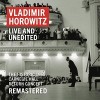
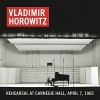
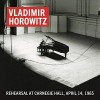
![The Welte-Mignon Mystery Vol.11 [0138-0] - Vladimir Horowitz](http://static.classicalm.com/repository/disk-cover/small/13002-img1664626443665713.jpg)
